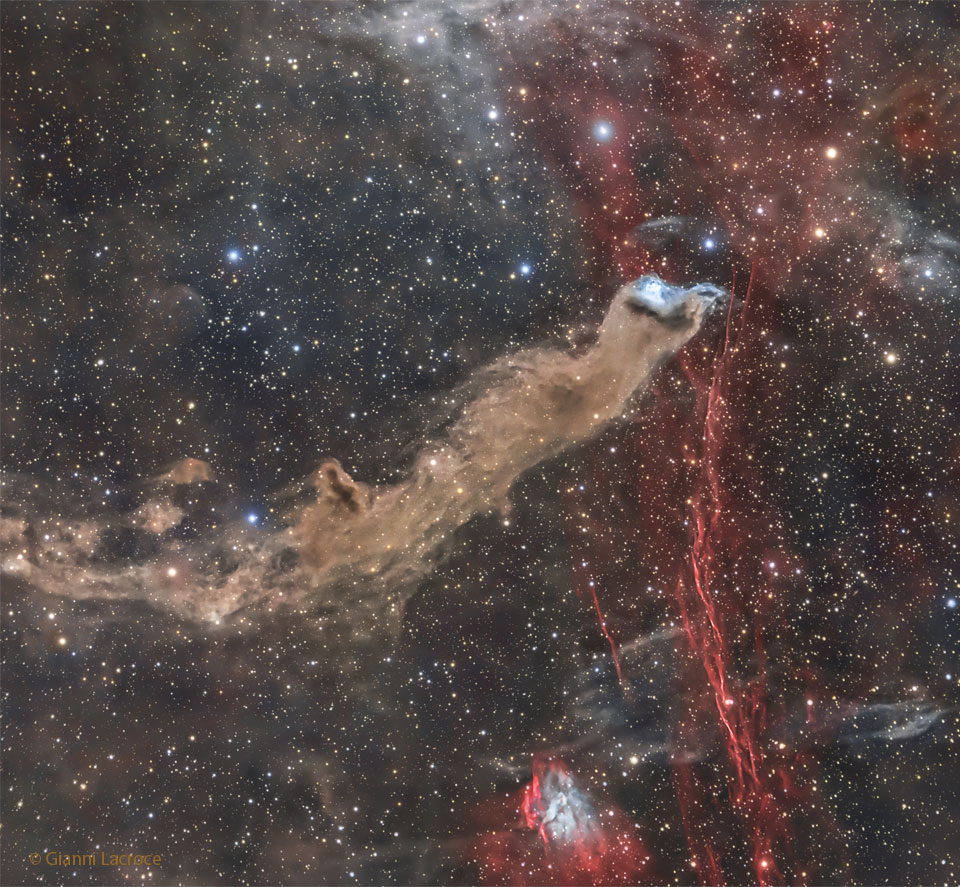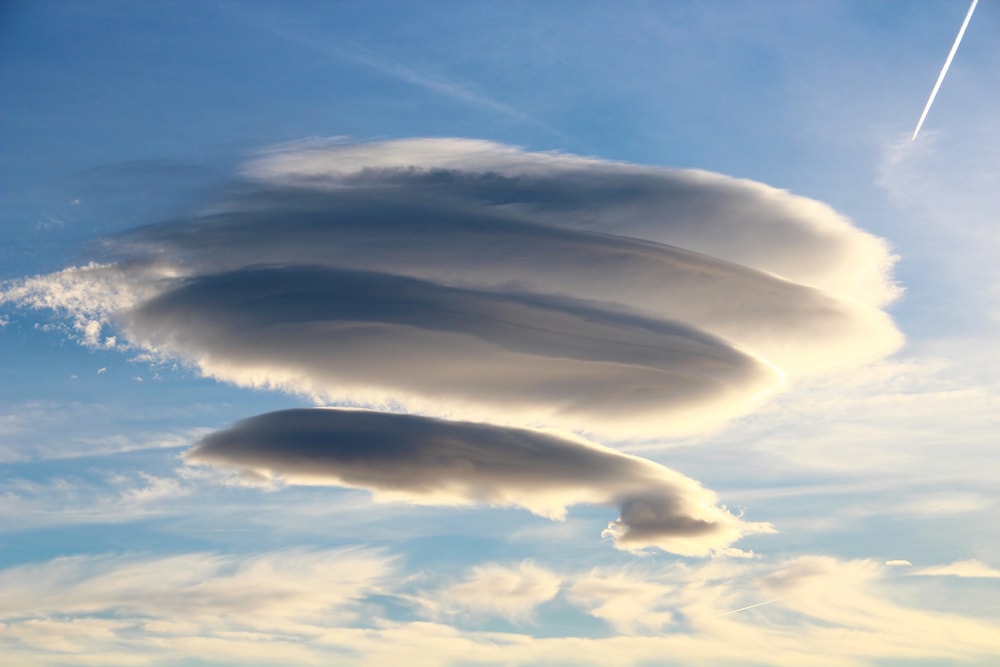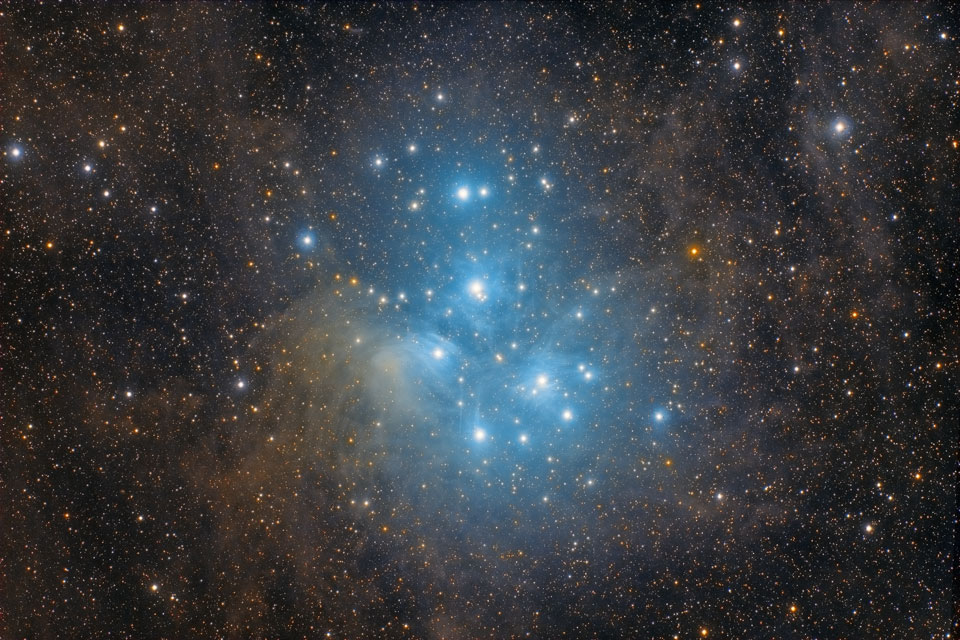Page 1 of 1
APOD: Wolf's Cave Nebula (2022 Nov 15)
Posted: Tue Nov 15, 2022 5:06 am
by APOD Robot
 Wolf's Cave Nebula
Explanation: The mysterious
Wolf's Cave Nebula
Explanation: The mysterious blue reflection nebula found in catalogs as
VdB 152 or Ced 201 really is very faint. It lies at the tip of the long
dark nebula Barnard 175 in a dusty complex that has also been called
Wolf's Cave. At the center of
this deep telescopic view, the
cosmic apparitions are nearly 1,400
light-years away along the northern Milky Way in the
royal constellation Cepheus.
Interstellar dust in the region
blocks light from background stars and
scatters light from the embedded bright star, giving the end nebula its characteristic blue color. Though
stars do form in
molecular clouds, this star seems to have only accidentally wandered into the area, as its measured velocity through space is very different from the cloud's velocity. At
the image bottom is the planetary nebula
Dengel-Hartl 5, while red glowing gas from an ancient supernova remnant is
also visible along the image's right side.
Re: APOD: Wolf's Cave Nebula (2022 Nov 15)
Posted: Tue Nov 15, 2022 7:02 am
by Ann
Beautiful image! The red details really make this image shine. Yes, I do like red sometimes, when it doesn't take over too much from the other colors, and particularly when there is some blue in the image to set it off!
Note the small bluish gray lenticular cloud above the "head" (or the mouth?) of the Wolf Cave Nebula:
Lentcular clouds above the Wolf's Cave Nebula.
As for the star lighting up the Wolf's Cave Nebula in blue, we are told in the caption that the star just blundered in there:
APOD Robot wrote:
Interstellar dust in the region blocks light from background stars and scatters light from the embedded bright star, giving the end nebula its characteristic blue color. Though stars do form in molecular clouds, this star seems to have only accidentally wandered into the area, as its measured velocity through space is very different from the cloud's velocity.
That's curious. When I googled the star, BD+69 1231,
Simbad Astronomical Database called it a young stellar object. I don't expect a young stellar object that has just recently emerged from its birth cocoon to leave its birthplace and just blunder into the best possible
other birthplace for young stars some distance away.
The Wolf's Cave Nebula, vdB 152,
looks like it might give birth to low-mass stars. Note the dark dust lane just below the bright blue reflection nebula. We expect stars to form from concentrated molecular clouds which look dark because of the presence of dust.
Take a look at this APOD from 2013 by Roberto Colombari, featuring the Pleiades:
The Pleiades have indeed just blundered into an unrelated dust cloud and lit it up. But the stars of the Pleiades are not young stellar objects. They are mature stars, about 100 million years old, and the brightest of the Pleiades are evolving off the main sequence.
Note, too, that although we can see a lot of dust in Roberto Colombari's image, there is no
concentrated dark dust anywhere. There is nothing there that loks like a potential birthplace for stars.
But the Wolf's Cave Nebula looks like it might be just that.
Ann
Re: APOD: Wolf's Cave Nebula (2022 Nov 15)
Posted: Tue Nov 15, 2022 2:07 pm
by orin stepanek
Ah; The wolf's cave! Is there a wolf star around? I don't Think wolves
live in a cave, thou I could be wrong! It Kinda; sorta, looks like a
bird to me ready to peck! I supose the birds eye would be the the
mouth of the cave! Can you see any wolves in it? Wolfs?


I noticed the Hartl name attached to this image; I have cousins with
that name!

Re: APOD: Wolf's Cave Nebula (2022 Nov 15)
Posted: Tue Nov 15, 2022 4:02 pm
by whatwhere
Where is the wolf? Where is the cave?
If anything, I see a young penguin (white face, beak, trail of bubbles after a dive or upturn).
Re: APOD: Wolf's Cave Nebula (2022 Nov 15)
Posted: Tue Nov 15, 2022 4:06 pm
by whatwhere
...Also an upswept wing. Almost uncanny, to be fair. Dare I say, un-canine!

But really, where is the wolf? Where is the cave?
Re: APOD: Wolf's Cave Nebula (2022 Nov 15)
Posted: Tue Nov 15, 2022 8:01 pm
by beryllium732
The blue bright stars a top of the nebula are they also at the same 1400 light years distance?
Re: APOD: Wolf's Cave Nebula (2022 Nov 15)
Posted: Tue Nov 15, 2022 9:37 pm
by heehaw
Ooops! Someone dropped a medical-test sample on that nice astronomical photograph
Re: APOD: Wolf's Cave Nebula (2022 Nov 15)
Posted: Tue Nov 15, 2022 10:35 pm
by johnnydeep
whatwhere wrote: ↑Tue Nov 15, 2022 4:06 pm
...Also an upswept wing. Almost uncanny, to be fair. Dare I say, un-canine!

But really, where is the wolf? Where is the cave?
The "Wolf" here is just the last name of the astronomer who got the credit for his assistant's discovery. From the "
Wolf's Cave" link in the description:
Max Wolf's assistant, August Kopff, photographically discovered the complex structure on October 21, 1908. To Wolf, it looked like a cave and he started calling it the Cave Nebula. Wolf also thought the nebula was an actual cave formation in the Milky Way stars. It was finally designated as vdB 152 and is still sometimes called Wolf's Cave.
Here is Max Wolf's Dec. 1908
announcement in the Monthly Notices of the Royal Astronomical Society, Vol. 69, p.117
Re: APOD: Wolf's Cave Nebula (2022 Nov 15)
Posted: Wed Nov 16, 2022 12:11 am
by whatwhere
johnnydeep wrote: ↑Tue Nov 15, 2022 10:35 pm
...The "Wolf" here is just the last name of the astronomer who got the credit for his assistant's discovery. From the "
Wolf's Cave" link in the description...
Well, now I feel silly!

I've often been frustrated when I see people that don't read a post fully, including the links provided, then comment in ignorance!

Somehow today was my turn. My own searches did not provide an answer. Apologies to all!
I must also express gratitude that someone (you) responded regardless!
I also see many posts that ask, "Where is the [insert name here]?" in the image, and no one cares to share. Though, I imagine so many that frequent this site, do actually know the answers.
Thank you!
P.S. I still don't see a cave!

Re: APOD: Wolf's Cave Nebula (2022 Nov 15)
Posted: Wed Nov 16, 2022 3:42 am
by orin stepanek
The "Wolf" here is just the last name of the astronomer who got the credit for his assistant's discovery. From the "
Wolf's Cave" link in the description:
Max Wolf's assistant, August Kopff, photographically discovered the complex structure on October 21, 1908. To Wolf, it looked like a cave and he started calling it the Cave Nebula. Wolf also thought the nebula was an actual cave formation in the Milky Way stars. It was finally designated as vdB 152 and is still sometimes called Wolf's Cave.
Here is Max Wolf's Dec. 1908
announcement in the Monthly Notices of the Royal Astronomical Society, Vol. 69, p.117
[/quote]
Well; I must confess that I was looking for a Wolf Star! I even read the Max Wolf's Cave Nebula story!

I still think it look's like a bird! I can also see a cave' with the bird's eye being the entrance of the cave!

Re: APOD: Wolf's Cave Nebula (2022 Nov 15)
Posted: Wed Nov 16, 2022 5:03 am
by Ann
beryllium732 wrote: ↑Tue Nov 15, 2022 8:01 pm
The blue bright stars a top of the nebula are they also at the same 1400 light years distance?
The bright blue star at the top of the nebula, SAO 10287 or BD+69 1231, has a Gaia parallax of 2.6998 ± 0.0139 milliarcseconds, which puts it at a distance of ~1,200 light-years.
And yes, the nebula is at the same distance as the star, because it is the star that lights up the nebula.
The star, by the way, is not all that extremely bright. It is similar to Sirius in brightness, so that it is some ~21 times brighter than the Sun. Admittedly it would look a bit brighter if it wasn't surrounded by a nebula, because it has "lost" some light to the nebula by lighting it up. But it still isn't "super-bright".
Ann
Re: APOD: Wolf's Cave Nebula (2022 Nov 15)
Posted: Wed Nov 16, 2022 7:23 am
by VictorBorun
Ann wrote: ↑Wed Nov 16, 2022 5:03 am
beryllium732 wrote: ↑Tue Nov 15, 2022 8:01 pm
The blue bright stars a top of the nebula are they also at the same 1400 light years distance?
The bright blue star at the top of the nebula, SAO 10287 or BD+69 1231, has a Gaia parallax of 2.6998 ± 0.0139 milliarcseconds, which puts it at a distance of ~1,200 light-years.
And yes, the nebula is at the same distance as the star, because it is the star that lights up the nebula.
The star, by the way, is not all that extremely bright. It is similar to Sirius in brightness, so that it is some ~21 times brighter than the Sun. Admittedly it would look a bit brighter if it wasn't surrounded by a nebula, because it has "lost" some light to the nebula by lighting it up. But it still isn't "super-bright".
Ann
I wonder why the dusty tail is curved like Sun's protuberance of plasma and magnetic field lines.
Can it be a smooth rotation of the stellar wind as the giant stars were passing through the space at the top of this APOD? If those giants are moving right to left, the direction of tail-blowing was rotating counter-clockwise
Re: APOD: Wolf's Cave Nebula (2022 Nov 15)
Posted: Wed Nov 16, 2022 7:34 am
by VictorBorun
Ann wrote: ↑Tue Nov 15, 2022 7:02 am
Note the small bluish gray lenticular cloud above the "head" (or the mouth?) of the Wolf Cave Nebula:
Detail from APOD 15 November 2022.png
Lentcular clouds above the Wolf's Cave Nebula.
I am totally at lost trying to think of a reason how the interstellar gas can imitate a lenticular cloud in the wind trail above a mountain
Re: APOD: Wolf's Cave Nebula (2022 Nov 15)
Posted: Wed Nov 16, 2022 12:46 pm
by johnnydeep
whatwhere wrote: ↑Wed Nov 16, 2022 12:11 am
johnnydeep wrote: ↑Tue Nov 15, 2022 10:35 pm
...The "Wolf" here is just the last name of the astronomer who got the credit for his assistant's discovery. From the "
Wolf's Cave" link in the description...
Well, now I feel silly!

I've often been frustrated when I see people that don't read a post fully, including the links provided, then comment in ignorance! Somehow today was my turn. My own searches did not provide an answer. Apologies to all!
I must also express gratitude that someone (you) responded regardless!
No problem. I try to answer the questions I can if no one else has done so already. "There are no silly questions" as my teachers used to say.
I also see many posts that ask, "Where is the [insert name here]?" in the image, and no one cares to share. Though, I imagine so many that frequent this site, do actually know the answers.
Thank you!
P.S. I still don't see a cave!

Yeah, I see no 'cave' either. Keep in mind that what people can see and imagine is highly dependent on the quality and resolving power of the optics used to take the image, as well as the particular filters used (if any) to restrict the output to specific wavelengths of light, and different optics can result in the emphasis (or even total absence) of radically different looking features. What might be evocative of a "wizard" or "flower" or "cave" in 1908, might be entirely lost in a modern image. And of course, sometimes, features simply get named after the discoverer.

Re: APOD: Wolf's Cave Nebula (2022 Nov 15)
Posted: Wed Nov 16, 2022 4:04 pm
by Ann
VictorBorun wrote: ↑Wed Nov 16, 2022 7:34 am
WolfsCave_Lacroce_3053 -.jpg
Ann wrote: ↑Tue Nov 15, 2022 7:02 am
Note the small bluish gray lenticular cloud above the "head" (or the mouth?) of the Wolf Cave Nebula:
Detail from APOD 15 November 2022.png
Lentcular clouds above the Wolf's Cave Nebula.
I am totally at lost trying to think of a reason how the interstellar gas can imitate a lenticular cloud in the wind trail above a mountain
Remember the Mandelbrot set? Where copies of the same shape are repeated at smaller and smaller (and maybe larger and larger) scales?
Maybe there are lenticular clouds above vdB 152 because there is a "wind trail" above a "mountain" below it - and that "mountain" is precisely the elongated cloud of gas and dust that is vdB 152?
Ann
Re: APOD: Wolf's Cave Nebula (2022 Nov 15)
Posted: Wed Nov 16, 2022 4:42 pm
by whatwhere
johnnydeep wrote: ↑Wed Nov 16, 2022 12:46 pm
Yeah, I see no 'cave' either. Keep in mind that what people can see and imagine is highly dependent on the quality and resolving power of the optics used to take the image, as well as the particular filters used (if any) to restrict the output to specific wavelengths of light, and different optics can result in the emphasis (or even total absence) of radically different looking features. What might be evocative of a "wizard" or "flower" or "cave" in 1908, might be entirely lost in a modern image. And of course, sometimes, features simply get named after the discoverer.

Yes! I don't imagine many people in 1908, let alone the few astronomers, had seen the underwater action of diving penguins. Otherwise it may very well have been named The Penguin!
Re: APOD: Wolf's Cave Nebula (2022 Nov 15)
Posted: Wed Nov 16, 2022 5:56 pm
by Fred the Cat
VictorBorun wrote: ↑Wed Nov 16, 2022 7:34 am
WolfsCave_Lacroce_3053 -.jpg
Ann wrote: ↑Tue Nov 15, 2022 7:02 am
Note the small bluish gray lenticular cloud above the "head" (or the mouth?) of the Wolf Cave Nebula:
Detail from APOD 15 November 2022.png
Lentcular clouds above the Wolf's Cave Nebula.
I am totally at lost trying to think of a reason how the interstellar gas can imitate a lenticular cloud in the wind trail above a mountain
Given an appetite for such things, I might label the nebula; "
Jaws of a Sandworm".
Hungry for
anything to spice up its existence.

On second thought, I don't think I "
otter".

Re: APOD: Wolf's Cave Nebula (2022 Nov 15)
Posted: Thu Nov 17, 2022 1:42 am
by Chris Peterson
VictorBorun wrote: ↑Wed Nov 16, 2022 7:34 am
I am totally at lost trying to think of a reason how the interstellar gas can imitate a lenticular cloud in the wind trail above a mountain
Easy. Pareidolia.
Re: APOD: Wolf's Cave Nebula (2022 Nov 15)
Posted: Thu Nov 17, 2022 7:15 pm
by beryllium732
Ann wrote: ↑Wed Nov 16, 2022 5:03 am
beryllium732 wrote: ↑Tue Nov 15, 2022 8:01 pm
The blue bright stars a top of the nebula are they also at the same 1400 light years distance?
The bright blue star at the top of the nebula, SAO 10287 or BD+69 1231, has a Gaia parallax of 2.6998 ± 0.0139 milliarcseconds, which puts it at a distance of ~1,200 light-years.
And yes, the nebula is at the same distance as the star, because it is the star that lights up the nebula.
The star, by the way, is not all that extremely bright. It is similar to Sirius in brightness, so that it is some ~21 times brighter than the Sun. Admittedly it would look a bit brighter if it wasn't surrounded by a nebula, because it has "lost" some light to the nebula by lighting it up. But it still isn't "super-bright".
Ann
Thank you! I wish there were a mouse clickable picture like the one the Deep Field pictures Hubble took so you can click on any galaxy and see the distance and redshift of it.
Re: APOD: Wolf's Cave Nebula (2022 Nov 15)
Posted: Sun Nov 20, 2022 11:37 pm
by starsurfer
Beautiful image! I think this name comes from the fact it was identified by someone called Max Wolf. Also DeHt 5 actually is an example of a PN mimic.
Re: APOD: Wolf's Cave Nebula (2022 Nov 15)
Posted: Mon Nov 21, 2022 4:31 am
by Ann
starsurfer wrote: ↑Sun Nov 20, 2022 11:37 pm
Beautiful image! I think this name comes from the fact it was identified by someone called Max Wolf.
Also DeHt 5 actually is an example of a PN mimic.
Thanks, starsurfer!

I wanted you to chime in on DeHt 5. It didn't look like a "true" planetary to me.
Ann
 Wolf's Cave Nebula
Wolf's Cave Nebula


